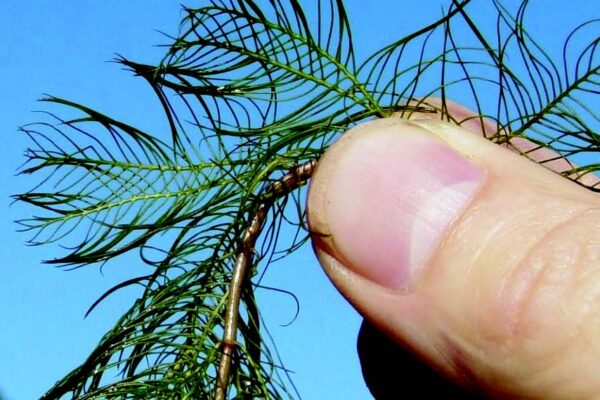Eurasian Watermilfoil

Species at a Glance
Eurasian watermilfoil is a feathery submerged aquatic plant that was once commonly sold as an aquarium plant. It quickly forms thick, damaging mats that are causing harm in shallow areas of rivers and lakes throughout North America.
Species Description
Eurasian watermilfoil has small (<2 cm long) feathery leaves that are arranged in whorls of 3-6 (four leaves per whorl is common) around slender stems. The plant grows underwater from roots attached firmly in the sediment. Tiny pink flowers grow on shoots that rise above the water’s surface. In Pennsylvania, these plants usually die back to the roots during the winter. Eurasian watermilfoil may be confused with bladderworts, hornworts, mermaid weeds, and other leafy milfoils.
Native & Introduced Ranges
Eurasian watermilfoil is native to Europe, Asia, and northern Africa. It was first discovered in the eastern United States in the 1940s but may have arrived as early as the late 1800s.
Since its introduction, it has spread across inland lakes and streams, clinging to boats and waterfowl. The history of its spread in the United States is not well documented because it bears such a close resemblance to native species of watermilfoil; however, it is now known to be established in nearly every U.S. state, and at least three Canadian provinces. In Pennsylvania, Eurasian watermilfoil is common in lakes, ponds, and rivers in all regions of the Commonwealth.
Biology & Spread
Eurasian watermilfoil does not rely on seeds for reproduction because they germinate poorly under natural conditions. Instead, it reproduces by fragmentation, which is when plant fragments break off and float via water currents, allowing it to disperse long distances. It can also cross land to new waters when these fragments, which can stay alive for weeks if kept moist, hitchhike on boats, boat trailers, motors, and fishing equipment.
Habitat
Eurasian watermilfoil is an extremely adaptable plant that is able to thrive in a variety of conditions. It is generally found in water less than 20 ft (6 m), and mats form in waters less than 15 ft (4.5 m). It grows in still to flowing waters, and tolerates a wide temperature range, even surviving under ice.
Impacts
Threat to Biodiversity
The rapid growth rate of Eurasian watermilfoil allows it to form dense mats across the water’s surface. These mats shade out native plants growing beneath. The reduction in native plant growth results in monotypic stands of watermilfoil that provide only a single habitat and food source for other organisms. In addition, lower numbers of nutrient-rich native plants impact the composition of aquatic invertebrates and may impair the ability of some fish species to spawn. Thick mats of milfoil can also slow the flow of moving water, decreasing the amount of oxygen available to fish and other organisms.
Economic Costs
Dense mats of Eurasian watermilfoil choke waterways and interfere with recreational activities such as swimming, fishing, and waterfowl hunting. They can also interfere with boating, as plant fragments become wrapped around propellers. Heavy infestations can obstruct industrial and power generation intakes and harm the economy by reducing local property values.
Prevention & Control
The physical or chemical removal of Eurasian watermilfoil mats can be expensive and are usually only temporary measures. Even the smallest plant fragment can colonize an uninfested area, making permanent removal extremely difficult. Preventing the spread of Eurasian watermilfoil to new areas is the best way to prevent further ecological impacts. Learn how to identify Eurasian watermilfoil from native milfoil species. Always remove any visible mud, plants, and debris from boats, trailers, and equipment before leaving a water body. Eliminate water from all equipment before transporting. Clean gear and equipment with either hot water (140°F/60°C), or salt water; OR let boats and equipment dry thoroughly for at least five days before entering a new water body.
References:
- Wisconsin Department of Natural Resources. 2008. Eurasian Watermilfoil. Factsheet.
- Rhoads, A.F., & Block, T. A. 2000. Eurasian Watermilfoil (Myriophyllum spicatum L.). Morris Arboretum of the University of Pennsylvania fact sheet.
- State of Washington Department of Ecology. Non-native invasive freshwater plants – Eurasian Watermilfoil.



